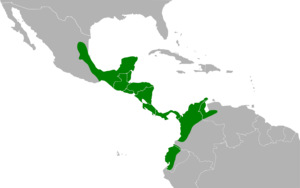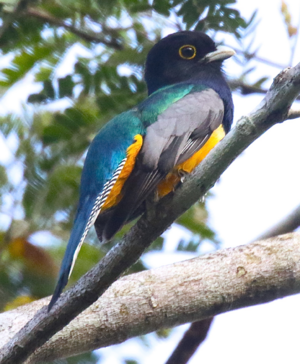Gartered trogon facts for kids
Quick facts for kids Gartered trogon |
|
|---|---|
 |
|
| Male, Mexico | |
 |
|
| Female, Panama | |
| Scientific classification | |
| Genus: |
Trogon
|
| Species: |
caligatus
|
 |
|
| Synonyms | |
|
Trogon violaceus caligatus |
|
The gartered trogon (Trogon caligatus) is a colorful bird. It belongs to the Trogonidae family. This family also includes the famous quetzals. You can find gartered trogons in Mexico and all over Central America. They also live in parts of Colombia, Ecuador, Peru, and Venezuela.
Contents
About the Gartered Trogon
What's in a Name?
For a long time, the gartered trogon was thought to be a subspecies. It was grouped with the violaceous trogon. But in the early 2000s, scientists decided it was its own unique species. This means it's now seen as different from the Amazonian trogon and the Guianan trogon.
Appearance and Colors
Most trogons have very different looks for males and females. Their feathers are often soft and brightly colored. The gartered trogon is about 23 to 25 centimeters (9 to 10 inches) long. It weighs between 38 and 57 grams (1.3 to 2 ounces).
The male gartered trogon is quite striking. His head, neck, and upper chest are a pretty violet-blue color. His face and throat are black. He has a pale yellow ring around his eye. A thin white band separates his upper chest from his bright yellow belly. His back feathers are a shiny metallic green. The top of his tail is violet-blue with black tips. The underside of his tail has fine black and white stripes. His wings are mostly black with some whitish parts.
The female looks different. Her head, face, upper chest, and back are gray. Her eye-ring is not a full circle. Her belly is a duller yellow than the male's. The underside of her tail has a different pattern of black and white.
Where They Live
Gartered trogons live in many places. You can find them in Mexico, Belize, Guatemala, and El Salvador. They also live in parts of Honduras and possibly Nicaragua. They are found from Costa Rica through Panama into western Colombia. You can also see them in western Ecuador and northwestern Peru. Some live in northern Colombia and western Venezuela.
These birds usually live in places that are not too dense. They like forest edges and clearings. You might see them in gallery forest (forests along rivers). They also live in secondary forest (forests that have grown back). Sometimes they live in shaded coffee and cacao farms. In Mexico, they can also be found in thicker evergreen forest and rainforest. They usually live in lowlands. They can be found up to 1,400 meters (4,600 feet) high in Central America.
Behavior and Life
What They Eat
The gartered trogon often eats by hovering in the air. It picks fruits and insects from plants. Unlike many other trogons, it eats a lot of fruit. But it also enjoys many kinds of insects and other small creatures. Sometimes, it joins groups of different bird species looking for food together.
Reproduction and Nests
The gartered trogon's breeding season happens at different times. In Mexico, it's from March to June. In El Salvador, it's May to July. In Costa Rica, it's February to June.
They build their nests in interesting places. They might use a wasp, ant, or termite nest in a tree. They also use holes in rotten trees. A female usually lays two or three eggs.
Their Calls
The gartered trogon has a special song. It's a long series of quick, hollow, downward-sounding notes. It sounds like "kyu-kyu-kyu-kyu-kyu-kyu". They also make a "rolling chattering" call.
Status in the Wild
Scientists keep track of how many gartered trogons there are. They are considered fairly common in most places they live. However, they are very rare in Venezuela. This means they are not currently in danger of disappearing.


